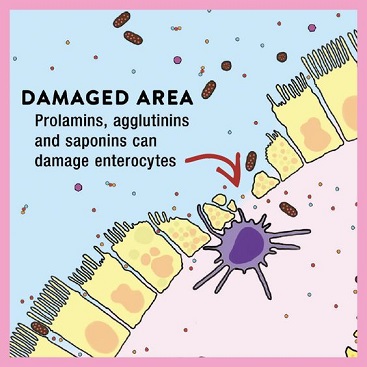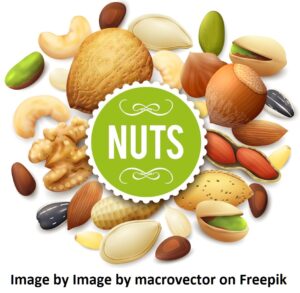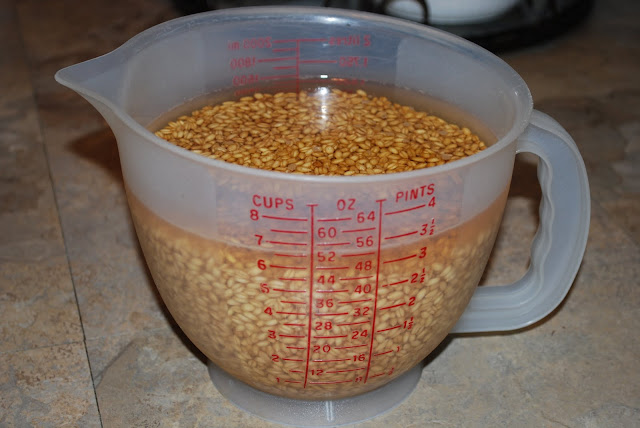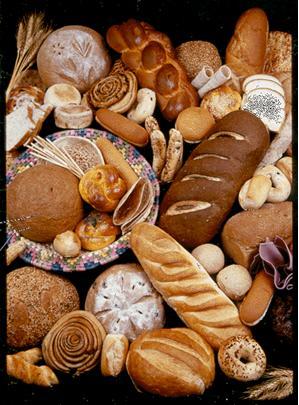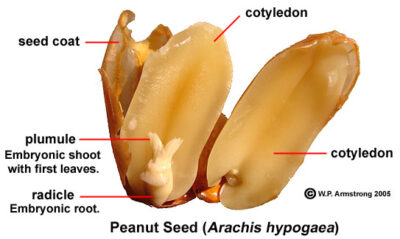Phytic acid / Phytate - Good or bad for you?

What is phytic acid / phytate?
Phytate (the salt form of phytic acid) is a plant seed’s storage form for ~70% of its phosphorus (also the B-vitamin inositol) – most of the seed’s phytate is broken down to release phosphorus and other nutrients, as a food source for the sprouting seed.
Phytate is especially found in cotyledons and outer hulls of the seeds of oil-producing plants – particularly in grains (bran and germ), legumes, nuts, and other edible seeds. The cotyledon is inside the germ and provides food for the first leaves. Shahidi F, 1997

What foods contain phytate?
Phytate is found in high amounts in: seeds and UNREFINED (whole) cereal grains (in the bran and the outer hulls), also found in the outer hulls of beans / legumes, nuts and other seeds.
- Some nuts have higher phytate content than some grains
- Vegetables have relatively small amounts
- Brans have extremely high phytate content
Phytate content depends on many factors – including growing conditions, harvesting techniques, processing methods, testing methods, age of the food being tested. Phytic acid will be much higher in foods grown using modern high-phosphate fertilizers than those grown in natural compost. Srivastava BN et al, 1955
| Some examples of phytate content in grains, legumes, nuts, seeds, fruits and vegetables | ||
|---|---|---|
| Food Source of Phytates | mg / g dry weight | |
LEGUMES |
Min. |
Max. |
| Cocoa powder (some brands ferment cacao beans to remove phytate) | 17 | 17 |
| Peanut butter (Jif) | 13 | |
| White beans(cooked) | 10 | 14 |
| Soybeans | 9 | 17 |
| Peanuts | 9 | 20 |
| Tofu | 9 | 18 |
| Black beans (cooked) | 8 | 17 |
| Kidney beans (cooked) | 8 | 13 |
| Navy beans | 7 | 18 |
| Refried beans | 6 | |
| Chickpea (cooked) | 3 | 13 |
| Lentils (cooked) | 2 | 10 |
| Green peas (cooked) | 2 | 11 |
NUTS / SEEDS |
Min. |
Max. |
| Sesame seeds (toasted) | 39 | 57 |
| Black walnuts | 20 | |
| Cashews | 19 | |
| Brazil nuts | 17 | |
| Almonds / Almond Butter* | 11 | 14 |
| English walnuts | 8 | 10 |
| Hazelnuts | 6 | 16 |
| Chestnuts | <1 | |
GRAINS |
Min. |
Max. |
| Wheat BRAN | 33 | 47 |
| Oat bran | 21 | 24 |
| Oats (low phytase enzyme content) | 14 | |
| Corn (low phytase enzyme content) | 14 | |
| Rice (unpolished, cooked) | 13 | 22 |
| Barley | 12 | |
| Amaranth | 11 | 15 |
| Rye (high phytase enzyme content) | 10 | |
| Buckwheat | 9 | 16 |
| Brown Rice | 8 | 9 |
| Wheat (durum) (high phytase enzyme content) | 7 | 10 |
| Oatmeal (porridge) | 7 | 10 |
| Popped corn | 6 | |
| Sorghum | 6 | 12 |
| Cornbread | 4 | 8 |
| Whole wheat bread | 4 | 10 |
| White flour | 2 | |
| Rye bread (high phytase enzyme content) | 2 | 4 |
| Pumpernickel bread | 2 | |
| Rice (white, polished, cooked) | 1 | 4 |
| Pasta | <1 | 9 |
| Cornflakes | <1 | 1 |
| White bread | <1 | 2 |
| French Bread | <1 | <1 |
| Sourdough Rye Bread | <1 | <1 |
| Soured buckwheat | <1 | |
FRUITS and VEGETABLES |
Min. |
Max. |
| Coconut (phytate is in a form that does not chelate minerals) | 4 | |
| Tubers | ||
| Broccoli | <1 | |
| Strawberries | <1 | |
| Collard greens | <1 | |
| Avocado | <1 | |
| Sweet potatoes / potatoes | <1 | |
| Green beans | ||
| Berries | ||
Figures collected from various sources, including: Phytic acid content in milled cereal products and breads
| Average phytic acid intake varies by country | |
|---|---|
| U.S. and U.K. | 631-746 mg/day |
| Finland | 370 mg/day |
| Italy | 219 mg/day |
| Sweden | 180 mg/day |

Phytic acid digestibility
Most phytic acid makes it through to the colon undigested and unabsorbed – phytic acid “laughs at” stomach acid and is not fazed by our intestinal enzymes; in the colon; bacteria that produce phytase enzymes can begin to break it down, but most phytate leaves the body intact taking its phosphorus and any bound nutrients with it. Therefore, phytic acid only interferes with minerals in the GI tract, not in the bloodstream or in our cells.
Phytic acid in food is only about 50% digestible by NON-ruminants – being able to chew the cud, ruminant animals can produce the phytase enzymes required to break down phytic acid. Humans cannot. Schlemmer U et al, 2009. However, humans have other ways to break down phytic acid in foods to improve their digestibility:
- Phytic acid can be degraded by phytase enzymes intrinsic to its host food – however, not all phytic acid-rich foods contain an abundance of phytase E.g. oats and corn do not
- By specific gut flora that produce phytase enzymes (more on this at the phytase enzymes link)
- Before consumption using traditional food preparation methods that produce phytase enzymes – i.e. soaking, ideally, followed by fermenting or sprouting. E.g. properly soaking beans can break down 1/3 to 2/3 of their phytate content. Cooking / Roasting (E.g. common in manufacturing breakfast cereals) barely degrades phytate, since the heat quickly destroys the phytase enzymes.

PHYTASE enzymes break down phytic acid
What is phytase and what does it do?
Phytase is any type of phosphatase enzyme that breaks down phytic acid (a chemical process called dephosphorylation, produces a phosphate ion and a molecule with a free hydroxyl group) – phytase catalyzes the hydrolysis (requires water) of phytic acid by removing a phosphate group from its substrate to release a usable form of inorganic phosphorus. Phytase activity is measured in FTU (a worldwide standard).
The break down of phytic acid by phytases results in two specific beneficial effects –both of which increase mineral availability and absorption (esp. bone-beneficial phosphorus)
(1) Allows the utilization/absorption of bound/stored nutrients in phytate -phytase can hydrolyze phytic acid, releasing phosphorus and other nutrients bound by phytic acid (E.g. minerals, protein and starch).
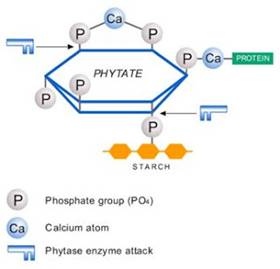
The binding is possible within a phosphate group or between two phosphate groups on either the same or different phytic acid molecules.
(2) Prevents phytic acid from binding to important minerals in the digestive tract – which would otherwise make them unavailable to the body.
Humans (and other non-ruminants) do produce phytase enzymes for breaking down phytic acid, but favorable gut bacteria do – interestingly, rat intestine had 30 times the phytase activity of the human intestine (ex-vivo) and therefore the results of rodent studies examining phytate degradation are unlikely to apply to humans. Iqbal TH et al, 1994
In germ and bran of whole seed / grain, germination activates phytase – which breaks down phytic acid and releases phosphorus and other minerals needed by the developing plant embryo for new growth. However, some grains contain more phytase than others:
- High phytase grains – Wheat contains 14 times more phytase than rice; rye contains over twice as much as wheat (the reason rye is preferred as a starter for sourdough breads). Egli I et al, 2002
- Oatmeal has a low phytase content
Phytase activity depends on pH with the ideal pH being somewhere in the ~4.5 – 5.5 range – adding a mild acid to soaking water of phytate foods creates that “just right” pH environment for phytase action. Note that the stomach acid pH is much lower and not conducive to phytase activity.
- pH was the most important factor in reducing the content of phytic acid during bread making. Phytic acid in doughs with pH 4.3-4.6 was more effectively reduced than in doughs with higher pH. Merete Mãller Nielsen et al, 2007
- Reale et al concluded that lactic acid bacteria improved conditions for degrading phytic acid simply by lowering pH. They determined the ideal pH to be ~ 5.5. Reale A et al, 2007
- Phytase activities are pH dependent with the highest activities being observed at a slightly acidic pH (5.1). Oatway L et al, Phytic Acid
- Bacterial flora in the colon produce phytase and also lactic acid that affects pH in favor of phytase activity. Dephosphorylation of phytic acid releases calcium ions, which are absorbed from the colon. Sandstrõm B et al, 1990
A high phytate diet improves the ability of intestinal microbiota to degrade phytate Markiewicz et al,2013 – This is a big deal! – because it means that gut microbes “step up to the plate” and improve their efficiency at producing phytase enzymes to degrade phytate when there is a dietary increase in phytates. However, studies show that at best, still only about half of the intestinal dietary phytate is broken down. Schlemmer et al, 2009. This may be because phytate has both negative and positive roles to play in the body. Interestingly, of the various microbes examined, gram-positive anaerobes and lactic acid bacteria (i.e. the ones in sourdough) appeared to be the least effective in the hydrolysis of phytic acid, and E. Coli performed the best.
The message to take home here is:
(1) The importance of having a favorable, balanced gut flora.
(2) We probably don’t need to go overboard with food preparation methods to reduce phytates unless our diet is “loaded” with them. If we moderate our phytate intake and consume animal fats containing natural vitamin A and vitamin D (mitigates effects of phytic acid), then healthy gut flora can probably deal with them on their own. Markiewicz LH et al, 2013; Schlemmer U et al, 2009
Phytase activity depends on temperature
Phytase activity is increased within an ideal temperature range.
Phytase is reduced /destroyed by:
- Steam heat. 176 °F in 10 mins. or less
- Heat-processing. E.g. being in a wet solution at 131-149 °F
Peers FG. Phytase of Wheat. The Biochemical Journal 1953 53(1):102-110.
- EXTRUDED bran and whole grain cereals (E.g. All-bran ®, Bran Buds) are a recipe for digestive disaster and mineral deficiencies. Slurries of extremely high phytate grains are forced through tiny holes at high temperatures and pressures, which destroy the phytase enzymes that might have broken down some of the phytate – you might be regular, but at what cost? – flaxseed (negligible phytate content) and prunes are your better bet.
- Freezing and long storage times. Fresh flour has more phytase than after being stored.
With WHOLE grains and legumes, cooking temperatures eventually destroy phytase altogether. Cooking alone is NOT enough to activate phytase for a significant reduction of phytic acid – To reduce phytic acid to a healthy level requires some preparation before cooking:
Campbell J et al. Nutritional Characteristics of Organic, freshly stone-ground sourdough and conventional breads. http://eap.mcgill.ca/publications/EAP35.htm..

Phytic acid has both bad and good health roles in the body
The bad – phytic acid is an antinutrient
Phytic acid in WHOLE grains, legumes, nuts, and other seeds eaten by humans and other NON-ruminants is considered to be an antinutrient:
- Phytic acid inhibits enzymes needed for digesting food.
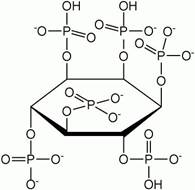
Csub>6H18O24P6
(Phytic acid, myoinositol hexaphosphate, IP6)
- “Mineral magnet” – Excess dietary phytic acid can cause mineral malabsorption / deficiencies in the body by chelating certain minerals – forming phytate. It’s snowflake-like molecule is basically an Inositol (vitamin B8) ring with 6 phosphate groups (“arms”) attached. The grasping “arms” of the phytic acid molecule tend to bind over a broad pH range to positively charged mineral ions (cations) (multivalent transition metals, such as calcium (Ca++), magnesium (Mg++), zinc(Zn++), iron(Fe++) copper(Cu++), cobalt (Co++) with 2 positive charges), This occurs both in its host food and also in your digestive tract to minerals that you consumed in other foods. It does not tend to bind to univalent mineral ions, such as potassium (K+) and sodium (Na+). Long-term – an early sign of phytic acid’s mineral-reducing effects is chronic tooth decay
Consuming too many phytic acid containing foods on a regular basis without soaking / sprouting / fermenting / cooking can cause several health issues related to nutrient availability / utilization – Particularly in those whose diet relies heavily on high phytic-acid containing plant foods
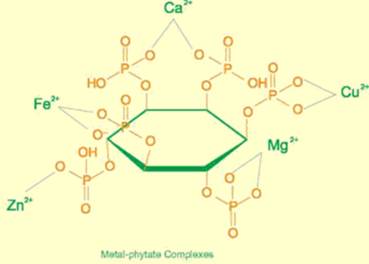
When phytic acid is bound / chelated to a mineral it becomes phytate
- Phytic acid negatively impacts utilization of protein and starch / carbohydrate by inhibiting enzymes needed for their digestion: Tannenbaum et al. 1985; Singh M and Krikorian AD, 1982
- Pepsin to break down protein in the stomach
- Trypsin for protein digestion in the small intestine;
- Amylase to convert starch into sugars
However, studies reveal that some people can consume phytic acid without adverse consequences – possibly mitigated by:
- Favorable gut flora – which produce phytase enzymes, and can actually adapt to a higher phytate (e.g. vegan/vegetarian) diet by increasing their phytase production. L.H. Markiewicz et al, 2013
- Study found little difference between iron-absorption of strict vegetarians (on regular high phytate diet) and control groups with and without added bran. Brune M et al., 1989
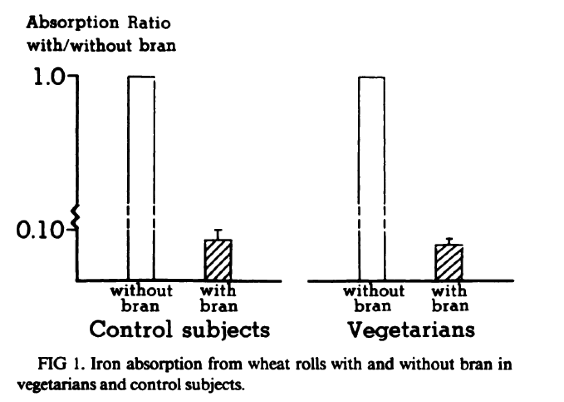
- Other dietary contributions – such as concurrent consumption of vitamin A and vitamin D (provided in animal fats).
There are several tactics you can use to reduce or mitigate the health-detrimental effects of excess phytate in the diet to increase digestibiiity and nutrient bioavailability;
Phytate Consumption Conclusions
The “Good” – Consumed in moderation, phytic acid also confers some health beneficial effects
The bible contains several positive references to eating bread (especially unleavened bread).
Dietary phytic acid (often referred to in studies as inositil hexaphosphate or IP6) has several health-protective functions:
- Strong antioxidant Graf E and Eaton JW, 1990 Binds transition metal ions, thwarting their role as oxidants. Phytic acid-rich diets may protect cells lining the intestinal mucosal membrane (epithelial cells) against iron-induced oxidative damage; Graf E and Eaton JW, 1985
- Interruption of cellular signal transduction,• Cell cycle inhibition
- Enhancement of natural killer (NK) cells activity.
Health benefits of phytic acid:
- Cancer
- Decreases risk of colonic cancers and protects against inflammatory bowel diseases – Although both Finland and Denmark populations consume equal amounts of fiber, the lower-risk Finns consume food items with 20-40% more phytic acid than the higher-risk Danes. Graf E Eaton JW, 1985
- Phytic acid shown to inhibit growth of cancer cells – e.g. leukemia, colon, breast, cervical,
prostate, liver, pancreatic, skin, and muscle. after seemingly being taken up by them after absorption from the GI tract. Vucenik I, Shamsuddin AM, 2006 - Blocks angiogenesis (formation of new blood vessels to feed cancer cells) and disrupts pre-formed vessels. Vucenik I et al, 2004
- Appears to enhance anti-cancer effect of chemotherapy
- Type 2 diabetes
- Coronary heart disease / Atherosclerosis – by lowering elevated serum cholesterol; reducing pathological platelet activity
- Kidney stone formation – by preventing calcification
- HIV-1
- Heavy metal toxicity – by binding to transition metals
- Osteoporosis. Protective effect of myo-inositol hexaphosphate (phytate) on bone mass loss in postmenopausal women.

Conclusions on phytate consumption
Moderation, gut population, preparation, nutrientation
Yeah ok – so I made up that last word 🙂
Consuming phytate has both beneficial and harmful effects on the body, and as with most things, balance is the key. However, high-phytate foods have become a staple, not only in developing countries, where cost is the driving factor, but also in the developed ones, which choose to put grains at the bottom of the food pyramid.
A moderate intake of phytate from occasional higher phytate whole foods is NOT a problem for anyone in good health on a traditional, balanced diet. This includes animal fats containing vitamin A and vitamin D (which mitigate effects of phytic acid) and a little fruit.
It is important to note that healthy gut microbiota will degrade some of your dietary phytate, actually increasing phytase enzyme production when you consume higher levels of phytate! Phytase enzymes degrade phytate, but at best, only about half of the intestinal dietary phytate is broken down. (Schlemmer et al 2009). This may be because phytate has both negative and positive roles to play in the body. We probably don’t need to go overboard with food preparation methods to reduce phytates unless our diet is “loaded” with them. Markiewicz LH et al, 2013
However, if high phytate foods comprise the main food source of two or more meals per day (usually true of today’s typical Western diet or a vegetarian diet), then to avoid a mineral deficiency or malabsorption of protein and carbohydrates, you should:
(1) Reduce consumption of grains, legumes, nuts and other edible seeds
In particular, think about removing or minimizing wheat from your diet. Wheat has its own set of problems aside from phytate;
Wheat – Ain’t what it used to be
(2) Attend to the health of your beneficial gut flora
Gut microflora produce phytase enzymes to degrade phytate
Supplement a good probiotic supplement. Improve the health of the microbiome encouraging production of phytase enzymes by beneficial bacteria and also provide lactic acid producing Lactobacilli, which create a lower pH environment more conducive to phytase activity. Look for a quality supplement with a minimum 30 billion CFU/day including multiple acid-resistant species/strains to survive the journey through the stomach acid.
- Consume fermented products. Traditionally made sauerkraut, kimchi, good probiotic-rich yogurt and kefir.
- Consume fiber-rich prebiotics to feed the probiotics. Includes tubers, rutabagas, parsnips, sweet potatoes, mushrooms, Jerusalem artichokes, stevia, radicchio, chicory and Belgian endive.
- Don’t take antibiotics. Unless of course it is absolutely necessary; also, don’t eat inorganic chicken, beef, or pork, since in the U.S., antibiotics are used to make the sources of these meats fatter and larger.
(3) Soak plus ferment or sprout phytate-containing foods before consumption
Why?
- PHOSPHORUS is vital for human bones and teeth, and health in general but . . . grains, legumes and nuts are not our best sources – which are meat, fish, dairy, eggs (a problem if you are a vegan)
- Higher amounts of PHOSPHORUS (and therefore phytate) found in plants grown using today’s typical commercial high-phosphate fertilizers – rather than natural compost. Srivastava BN et al, 1955
- Many cultures consume grains and beans as staples of their diet – and that includes Westerners, who mistakenly have grains at the bottom of their food pyramid. Vegans or vegetarians center their diet around high-phytate foods as sources of protein amino acids.
World Consumption of Phytic Acid
Appropriate preparation of whole grains, seeds, nuts and legumes has the following benefits:
- Makes their chelated minerals bioavailable.
- Prevents their phytic acid from leaching digested minerals from the GI tract.
- Mitigates phytic acid’s ability to reduce protein and starch digesting enzymes.
- Removes other antinutrients, such as lectins and protease inhibitors
Several traditional household food preparation methods can be used to enhance the bioavailability of nutrients in high phytate content foods:
- Heat treatment (cooking/roasting until heat destroys phytase enzymes)
- Mechanical processing (E.g. grinding)
- Soaking (partial germination), Germination (sprouting), Fermentation (souring) – to activate naturally present (or added) phytase enzymes to break down the phytic acid.
Grains – How to prepare for healthy consumption
Legumes – How to prepare for healthy consumption
(4) Mitigate phytate’s mineral-blocking effect by ensuring certain dietary nutrients
- Vitamin A and Vitamin D from animal fat (lard, grass-fed butter and cream, fish liver oil, organ meats). Aid absorption of vitamins and minerals contained in grains (calcium, phosphorus, iron, B vitamins, etc.) and any others you have eaten
- Beta-carotene in your daily diet to counteract phytic acid’s reduction of iron absorption. Found in brightly colored fruits and vegetables.
- Consume vitamin C with phytate-rich meals. Counters iron loss
- Obtain absorbable calcium. From raw milk, raw cheese, yogurt, kefir, bone broths, supplements.
- Obtain vitamin D – Get out in the sun, consume animal fats or supplement vitamin D. Shown to mitigate mineral-blocking effects of phytic acid

The world consumes a lot of phytic acid in grains
| World’s Food group Totals | |
|---|---|
| Food group | Estimated edible dry matter ( Million metric tons) |
| Cereals | 1,545 |
| Tubers | 136 |
| Pulses | 127 |
| Meat, milk, eggs | 119 |
| Sugar | 101 |
| Fruit | 34 |
The world’s top 5 food crops (see chart) ALL have high phytate content – and of interest, wheat, corn, rice, barley, sorghum,;oats, rye, and millet provide 56% of the food energy and 50% of the protein consumed on earth (1985 figures). Stoskopf NC, 1985
Of 195,000 species of edible plants, only ~17 species provide 90% of mankind’s food supply
World’s top 30 food crops
| Food crop | Estimated edible dry matter (million metric tons) |
|---|---|
| Wheat | 468 |
| Maize | 429 |
| Rice | 330 |
| Barley | 160 |
| Soybean | 88 |
| Cane sugar | 67 |
| Sorghum | 60 |
| Potato | 54 |
| Oats | 43 |
| Casava | 41 |
| Sweet potato | 35 |
| Beet sugar | 34 |
| Rye | 29 |
| Millet | 26 |
| Rapeseed | 19 |
| Bean | 14 |
| Peanut | 13 |
| Pea | 12 |
| Musa | 11 |
| Grape | 11 |
| Sunflower | 9.7 |
| Yams | 6.3 |
| Apple | 5.5 |
| Coconut | 5.3 |
| Cottonseed (oil) | 4.8 |
| Orange | 4.4 |
| Tomato | 3.3 |
| Cabbage | 3.0 |
| Onion | 2.6 |
| Mango | 1.8 |
Prior to the Agricultural Revolution and man living in settlements, humans existed as non-cereal-eating hunter-gatherers, obtaining calories mostly from wild animal meats, fruits and vegetables (i.e. not from grains) – Furthermore, this drastic dietary change occurred without any significant change to mankind’s genetic make-up, and although it can easily provide the bulk of needed daily caloric intake, a cereal-based diet may or may not be wholly beneficial for human physiology:
Several health issues were recognized after the change from hunter-gatherer to cereal-based diets – including:
- Stature ▼ [1, 2-4],
- Infant mortality ▲ [4,5]
- Lifespan ▼ [4,5],
- Infectious disease incidences ▲ [4-7]
- Iron deficiency anemia ▲ [4, 5, 7]
- Osteomalacia incidence and other bone mineral disorders ▲ [1, 4, 5, 7] and number of dental caries and enamel defects ▲ [4.5, 8].
1. Eaton SB, Nelson DA: Calcium in evolutionary perspective. Am J Clin Nutr 1991;54:281s-287s.
2. Angel JL: Paleoecology, paleodemography and health; in Polgar S (ed): Population, Ecology and Social Evolution. The Hague, Mouton, 1975, pp 167-190.
3. Nickens PR: Stature reduction as an adaptive response to food production in Mesoamerica. J Archaeol Sci 1976;3:31-41.
4. Cohen MN: The significance of long-term changes in human diet and food economy; in Harris M, Ross EB (eds): Food and Evolution. Toward a Theory of Human Food Habits. Philadelphia, Temple University Press, 1987, pp 261-283.
5. Cassidy CM: Nutrition and health in agriculturalists and hunter-gatherers: A case study of two prehistoric populations; in Jerome RF, Kandel RF, Pelto GH (eds): Nutritional Anthropology:Contemporary Approaches to Diet and Culture. Pleasantville, Redgrave Publishing Company, 1980,pp 117-145.
6. The Third Chimpanzee: The Evolution and Future of the Human Animal. New York,Harper Collins, 1992, pp 180-191.
7. Lallo JW, Armelagos GJ, Mensforth RP: The role of diet, disease, and physiology in the origin of porotic hyperostosis. Human Biol 1977;49:471-473.
8. Turner CG: Dental anthropological indications of agriculture among the Jomon people of central Japan. Am J Phys Anthropol 1979;51:619-636.

References
Brune M et al. No intestinal adaptation to a high-phytate diet. American Journal of Clinical Nutrition 1989; 49: 542-545. PubMed
Egli I et al. The Influence of Soaking and Germination on the Phytase Activity and Phytic Acid Content of Grains and Seeds Potentially Useful for Complementary Feeding. Journal of Food Science 2002 Vol. 67, Nr. 9.
Graf E. Eaton JW. Amtioxidant functions of phytic acid (1990) Free Rad Biol Med 8(1):61-9
Graf E, Eaton JW Dietary suppression of colonic cancer. (1985) Cancer. Aug 15;56(4):717-8.
Living with Phytic Acid, Weston Price Foundation
Merete Møller Nielsen, Marianne Linde Damstrup, Agnete Dal Thomsen, Søren Kjærsgard Rasmussen, Åse Hansen . Phytase activity and degradation of phytic acid during rye bread making by Eur Food Res Technol 2007 Springer Nature Link
Lori Oatway a; Thava Vasanthan b; James H. HelmField Phytic Acid Food Reviews International by Crop Development Centre, Lacombe, Canada b Department of Agricultural Food and Nutritional Science, University of Alberta, Edmonton, Canada
Reale A, Konietzny U, Coppola R, Sorrentino E, and Greiner R, 2007, ‘The importance of lactic acid bacteria for phytate degradation during cereal dough fermentation’, Journal of Agriculture and Food Chemistry, 55 (8), pp 2993-2997 ACSPub
Sandström, B., Cederblad, A., Stenquist, B., & Andersson, H. (1990). Effect of inositol hexaphosphate on retention of zinc and calcium from the human colon. European Journal of Clinical Nutrition, 44, 705-708.
Schlemmer, U, Frølich, W, Prieto, RF. and Grases, F. (2009) Phytate in foods and significance for humans: food sources, intake, processing, bioavailability, protective role and analysis. Mol Nutr Food Res 53, S330-S375.
Shahidi F. (1997) Beneficial Health effects and drawbacks of antinutrients and phytochemicals in foods In: Shahidi F (Ed) Antinutrients and Phytochemical in Foods. Am Chem Soc Symp. Series 662
Singh M and Krikorian AD. Inhibition of trypsin activity in vitro by phytate. Journal of Agricultural and Food Chemistry 1982 30(4):799-800.
Srivastava BN et al. Influence of Fertilizers and Manures on the Content of Phytin and Other Forms of Phosphorus in Wheat and Their Relation to Soil Phosphorus. Journal of the Indian Society of Soil Science. 1955 III:33-40.
Stoskopf NC: Cereal Grain Crops. Reston, Reston Publishing Company, 1985.
Tannenbaum et al. Vitamins and Minerals, in Food Chemistry, 2nd edition. OR Fennema, ed. Marcel Dekker, Inc., New York, 1985, p 445.














